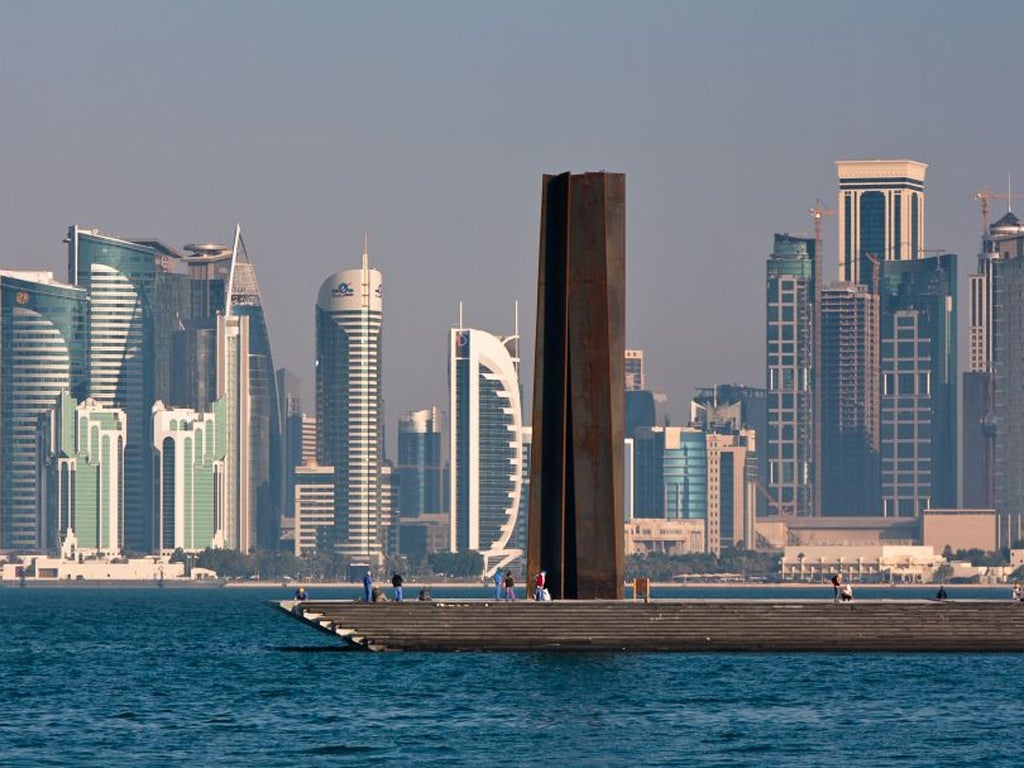The magnificent '7' adds an edge to Doha's gloss
Richard Serra reveals the inspiration behind his 80ft landmark to Jay Merrick

Your support helps us to tell the story
From reproductive rights to climate change to Big Tech, The Independent is on the ground when the story is developing. Whether it's investigating the financials of Elon Musk's pro-Trump PAC or producing our latest documentary, 'The A Word', which shines a light on the American women fighting for reproductive rights, we know how important it is to parse out the facts from the messaging.
At such a critical moment in US history, we need reporters on the ground. Your donation allows us to keep sending journalists to speak to both sides of the story.
The Independent is trusted by Americans across the entire political spectrum. And unlike many other quality news outlets, we choose not to lock Americans out of our reporting and analysis with paywalls. We believe quality journalism should be available to everyone, paid for by those who can afford it.
Your support makes all the difference.The rusting slabs of German-made steel, all 735 tons of them, jut upwards 80ft from a blade of concrete lying over the softly grained, pale blue waters of the Bay of Doha. The asymmetric steel surfaces overlap, creating abstractions of texture and shadow. Richard Serra, the feted American sculptor, has done a number in what is the most strategically wealthy city in the world. And the number is seven.
Or 7, to give this monument its correct name. Those familiar with London's Liverpool Street station will recognise the form. The Doha version is much taller – the tallest Serra has made – and more elegant than the bruiser that taunts the effete postmodern architecture around Liverpool Street.
Serra's Doha sculpture took a million man-hours and one year to build. It rises from the projecting point of Doha's Corniche, a crescent esplanade that has replaced the container port which covered the same stretch of seafront only 12 years ago. And so, 7 more or less floats on the sea, 300m adrift of the magnificent Museum of Islamic Art, designed by IM Pei: it's geometry, precise shadow-lines, and beautiful materiality are perfectly built, and imply eternity. On the other side of the water is the West Bay business quarter, whose buildings – apart from Jean Nouvel's beautifully crafted tower – are the equivalent of gaudily overdressed prats at a 1980s disco.
Serra's 7 mediates these two starkly different conditions – historic Islamic culture, greed is good – like a very big, tough tuning fork of raw, individual creativity. The 72-year-old Serra visioned a structure that expressed something of the cultural mother-load in the museum and duly became "very interested in Islamic minarets. I studied them from Spain to the Yemen."
And then, the key flash of inspiration: the Ghanzi minaret in Afghanistan. "Minarets are round in section," he says. "The Ghanzi minaret is the only one that unfolds in a planar manner. And I thought it could dovetail with my own idea for a sculpture."
The 200ft long tongue of land and concrete that carries 7 out to sea was as important as the sculpture. "If you think of making a plaza in the Renaissance," says Serra, "and you think of a vertical structure, it will function as a campanile. If you think of a beacon on an island, it's a lighthouse. If you think of it at the end of an esplanade, it becomes a destination point." And one that was conceived by Serra and Sheikha Al Mayassa, daughter of the Emir of Qatar, as the most decisive and public coming together of Qataris and western art. The one sight-line through 7 leads, quite precisely, to the museum's vast sea-facing glazed wall.
The Sheikha's involvement is not casual. She and her mother, Sheikha Mosa, are now the world's most powerful buyers of modern and contemporary art, and Sheikha Al Mayassa's opinion certainly helped to convince Serra to drop his original design for an eight-sided structure. The move to seven sides was sealed when Serra encountered the history of heptagons, first outlined by Pythagoras as a flat outline. It was the Persian mathematician and astronomer, Abu Sahl al-Quhi, who created the first seven-sided structure in the 10th century.
The number, seven, is considered mystic in the Islamic world. Serra's 7 is not mystic. The sculpture's form might suggest the oddly skewed structural roots of a skyscraper. But this is a cross-cultural construction – one that gives Doha's money-no-object gloss a new and challenging edge.
Serra's 7, not to mention the current, highly provocative Cai Guo-Giang show at Doha's Mathaf Arab Museum of Modern Art, have given the contemporary arts scene here a meaningful jolt. An upcoming Damien Hirst blockbuster exhibition and Haruki Murakami show will now be utterly trivial.
Join our commenting forum
Join thought-provoking conversations, follow other Independent readers and see their replies
Comments